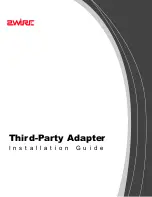
AT-S79 Management Software User’s Guide
Section I: Using the Menus Interface
87
Configuring the PVID of Untagged Ports
This procedure adjusts a port’s VID value. The PVID value determines the
VLAN in which the port is an untagged member. A port can be an
untagged member of only one VLAN at a time. A port is an untagged
member of the VLAN whose VID value matches its PVID.
The ports of a new VLAN are initially designated as tagged ports. Their
PVID values retain their previous settings when they are assigned to a
new VLAN. If you want the ports to function as untagged members of a
new VLAN, you must change their PVID values to match the VID of the
VLAN, as explained in this procedure.
You can also use this procedure to change the VLAN assignment of an
untagged port. With this procedure you can move an untagged port from
one VLAN to another by changing its PVID value.
To adjust the PVID value of a port, perform the following procedure:
1. From the Main Menu, type
A
to select
Advanced Switch
Configuration
.
The Advanced Switch Configuration Menu is shown in Figure 14 on
page 59.
2. From the Advanced Switch Configuration Menu, type
V
to select
VLAN
Management
.
The VLAN Management Menu is shown in Figure 20 on page 84.
3. Type
S
to select
Set Port Config
.
The VLAN Port Configuration Menu is shown in Figure 20 on page 84
4. Type
V
to select
Set Port VID
.
The following prompt is displayed:
Set PVID->Enter port number
5. Type the number of the port whose PVID value you want to configure
and press Enter. You can configure only one port at a time.
The following prompt is displayed:
Enter PVID for port
n
6. Type the new PVID for the port and press Enter. The PVID should
equal the VID of the VLAN where you want the port to be an untagged
member.
Summary of Contents for AT-S79
Page 6: ...Contents 6 ...
Page 10: ...Tables 10 ...
Page 22: ...22 Section I Using the Menus Interface ...
Page 28: ...Chapter 2 Getting Started with the Menus Interface 28 Section I Using the Menus Interface ...
Page 64: ...Chapter 5 Port Trunking 64 Section I Using the Menus Interface ...
Page 70: ...Chapter 6 Port Mirroring 70 Section I Using the Menus Interface ...
Page 94: ...Chapter 7 Virtual LANs 94 Section I Using the Menus Interface ...
Page 106: ...Chapter 8 Quality of Service QoS 106 Section I Using the Menus Interface ...
Page 118: ...Chapter 9 802 1x Port based Network Access Control 118 Section I Using the Menus Interface ...
Page 124: ...Chapter 10 RADIUS Authentication Protocol 124 Section I Using the Menus Interface ...
Page 134: ...134 Section II Using the Web Browser Interface ...
Page 166: ...Chapter 15 Port Configuration 166 Section II Using the Web Browser Interface ...
Page 172: ...Chapter 16 Port Trunking 172 Section II Using the Web Browser Interface ...
Page 176: ...Chapter 17 Port Mirroring 176 Section II Using the Web Browser Interface ...
Page 186: ...Chapter 18 Virtual LANs 186 Section II Using the Web Browser Interface ...
Page 192: ...Chapter 19 Quality of Service QoS 192 Section II Using the Web Browser Interface ...
Page 204: ...Chapter 23 Management Software Updates 204 Section II Using the Web Browser Interface ...
Page 208: ...Appendix A AT S79 Software Default Settings 208 ...
















































